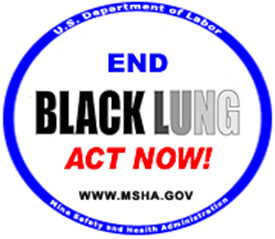MSHA Should Not Reduce Protection from Black Lung

In December, the Trump Administration announced it is considering rolling back MSHA regulations that protect coal miners from “black lung” disease, which comes from breathing in coal dust. The Mine Safety and Health Administration (MSHA) published a notice in the Federal Register that it wants public comments on the Respirable Coal Mine Dust Rule. Regulatory Reform of Existing Standards and Regulations; Retrospective Study of Respirable Coal Mine Dust Rule.
The notice stated: “MSHA is requesting public comment on two issues: (1) MSHA’s existing standards and regulations that could be improved or made more effective or less burdensome by accommodating advances in technology, innovative techniques, or less costly methods, including the requirements that could be streamlined or replaced in frequency; and (2) The Agency’s retrospective review of the final rule entitled Lowering Miners’ Exposure to the Respirable Coal Mine Dust, Including Continuous Personal Dust monitors (CPDM) (Dust). Stakeholder comments will assist MSHA in evaluating whether modifications of existing standards and regulations can better achieve regulatory objectives and, for the retrospective study, will assist MSHA in evaluating whether the final Dust rule is achieving respirable dust levels to protect miners’ health.”
Black lung is a lung disease caused by breathing coal mine dust. The coal and rock dust scars the fine tissue of the lungs, making the tissue less flexible, and it causes emphysema. As a result, the ability to inhale and exhale freely becomes impaired. Over time, black lung cripples miners as they become unable to walk short distances or climb a flight of stairs due to severe shortness of breath. There is no cure for this disease.
The Coal Mine Dust Rule under review was proposed by MSHA in 2009. The Rule was based on recommendations from the National Institute for Occupational Safety and Health (NIOSH) published in 1995 which recommended reduction in permissible exposure limits as a means of reducing black lung. The final rule was adopted in 2015, after MSHA held public hearings and reviewed lengthy comments. The rule survived a court challenge by the National Mining Association and Murray Energy. On August 1, 2016, Phase III of MSHA’s respirable dust rule went into effect. Phase III reduced the concentration limits for respirable coal mine dust from 2.0 milligrams of dust per cubic meter of air (mg/m3) to 1.5 mg/m3 at underground and surface coal mines.
Congress made eliminating black lung a national goal in 1969 by passing legislation intended to end black lung, but between 1968 and 2014, more than 76,000 coal miners nationwide died from the disease. Recent data from the NIOSH–administered Coal Workers’ Health Surveillance Program shows that the rate of black lung among coal miners with at least 25 years underground in West Virginia, Kentucky, and Virginia is higher than ever before. Based on current data, about 1 in 20 of these coal miners will now get severe black lung while the earliest data (from 1970) only showed that about 1 in 30 would.
Modern underground mining is done with high speed mechanized equipment which grinds the coal and rock from the coal seam, and which creates fine minute dust which floats in the air. Methods to protect miners from dust exposure include reduction in respirable dust through the use of proper ventilation to take the dust away from the miners and the use of water sprays to dampen dust as the coal is mined. We are familiar with the abuses of these protective measures told to us repeatedly by our clients in black lung benefits cases. Too many times the interest of mining more coal takes priority over properly hanging ventilation curtains and repairing damaged or clogged water lines. Without proper enforcement of dust limits, it is not surprising that there is a surge in severe black lung. The dust limits should have been reduced earlier and effective enforcement is needed. Black lung is preventable and it should be eliminated.
The NIOSH data reaffirms the need for safer working conditions for coal miners. Now is not a time to reduce those protections through a retrospective review with the stated purpose of the review whether the rules could be made “less burdensome”, “less costly”, “streamlined” or “replaced in frequency”.
5 Responses to “MSHA Should Not Reduce Protection from Black Lung”
Thank you Steve for presenting this so clearly.
Reducing protections from coal mine dust would demonstrate complete disregard for the health and safety of miners.
Heck no. They regulations were not followed correctly before. Making them less would result in more suffering for working men. The process for black lung program and the disregards from the John Hopkins medical black lung program are examples of the retaliation coal miners have faced.
At my husband’s mine they would shut down equipment when federal inspection was present. Men would report and that game harmed the men.
Sad it is. So much disregard for coal miners health.
If you need me for hearing, I will come to government hearings. Widow Marsha Jones
My husband filed a case and will only receive 12,000 and they will cut 40% out of that and he want end up with very little. Is there anyway I can get in contact with the main pwople4and find oit why some and getting more than my husband and some are only getting cut 25% . I feel something isn’t right
Amen, Steve.
[…] This post originally appeared at our blog dedicated to covering black lung issues, Devil in the Dust. […]
Comments are closed.